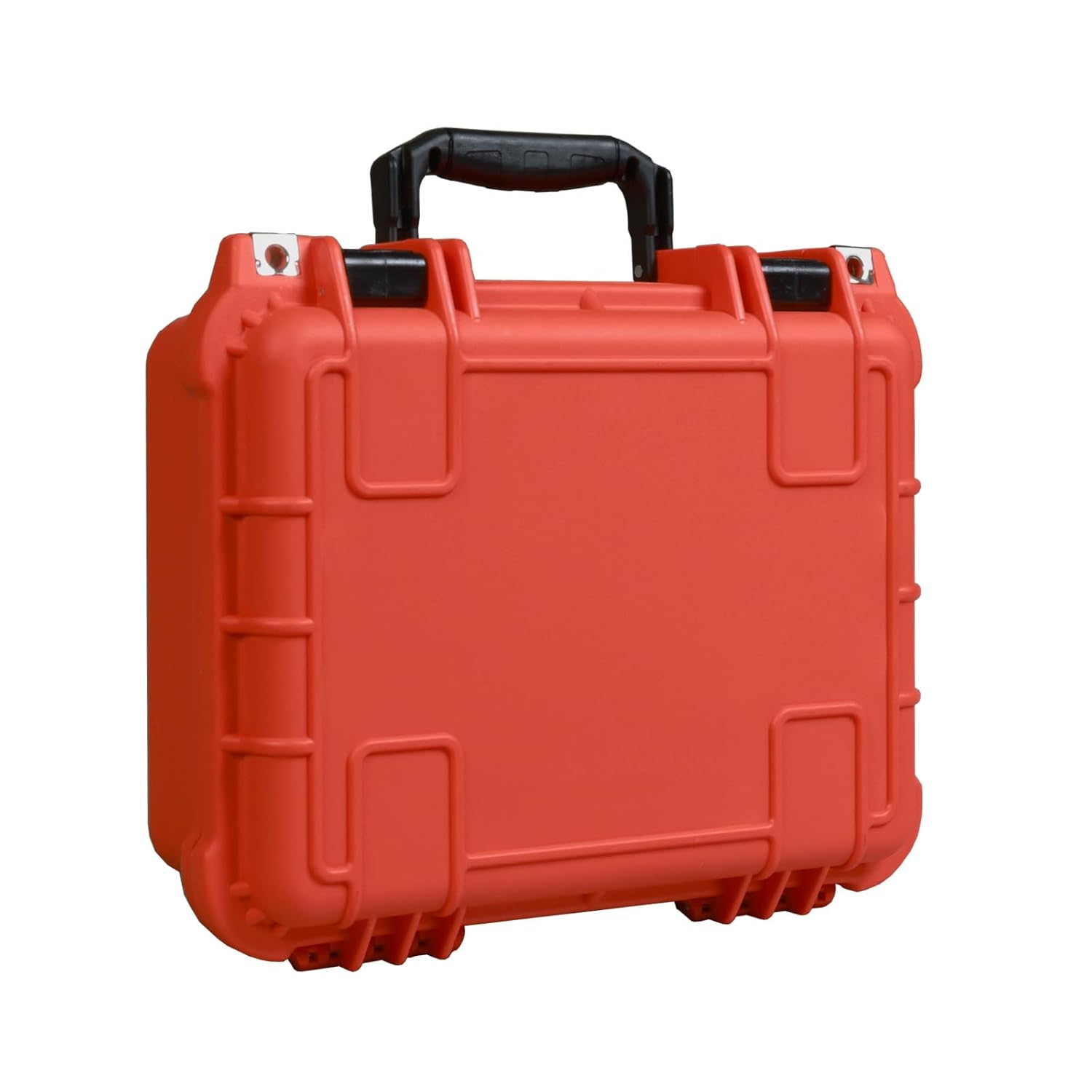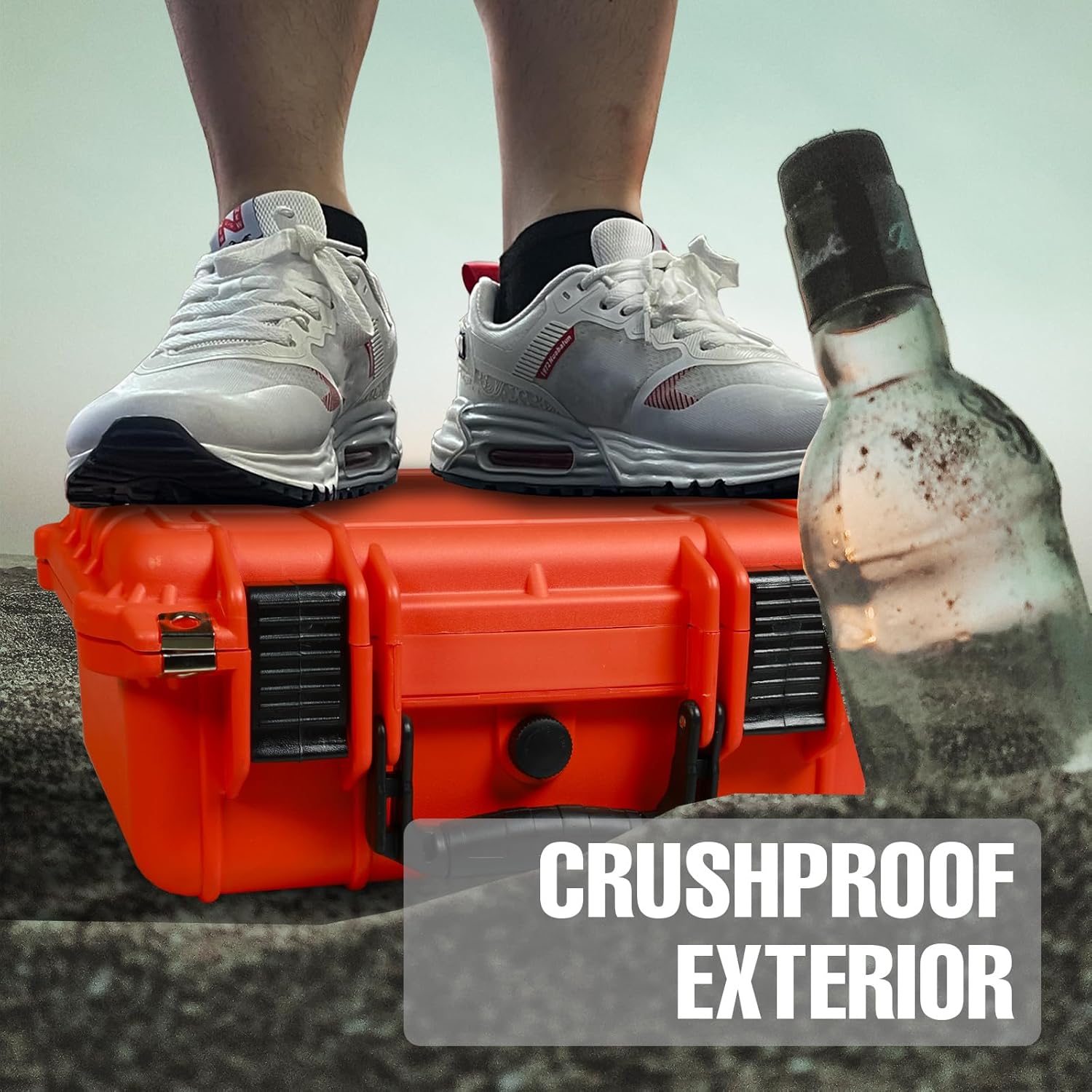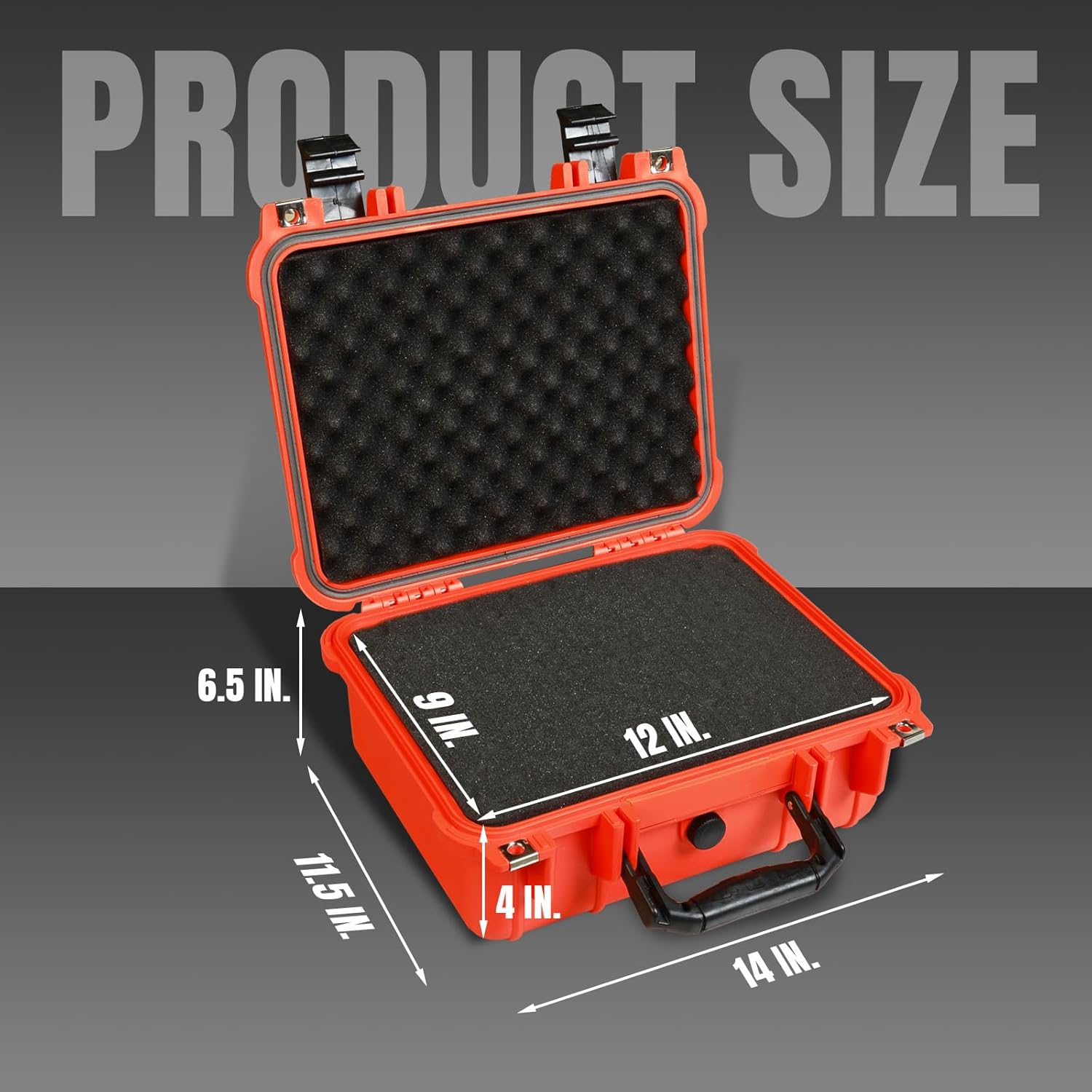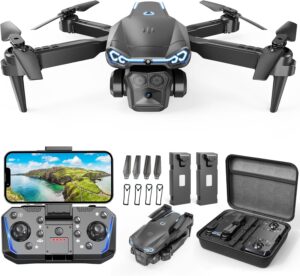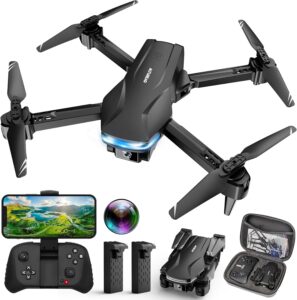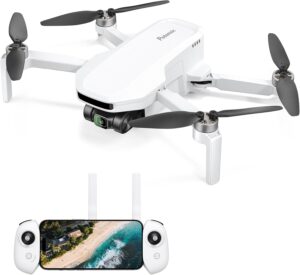Have you ever noticed how our most precious gear is always the thing we toss into a bag last, muttering “It’ll be fine,” as if fate were a polite guest who wouldn’t dare contradict us?
What We Noticed First: Size, Color, and Attitude
Right out of the box, the 14x 11.5x 6.5 Inch Hard Case, Portable Weather Waterproof Protective Camera Case with Customizable Foam, Fit Use of Drones, Camera, Equipments, Orange makes itself known. The color is a cheerful, high-visibility orange that says, “We’re over here, with the battery you swore you packed.” It’s the kind of orange that makes us feel prepared, even if we’re mostly prepared to admit we forgot something.
In terms of footprint, this is a mid-sized hard case. It’s compact enough to carry in one hand but big enough to feel like an organized decision. For a day shoot, a short flight, or a weekend project involving small tools and pricey electronics, this size hits a lovely sweet spot.
14x 11.5x 6.5 Inch Hard Case, Portable Weather Waterproof Protective Camera Case with Customizable Foam, Fit Use of Drones, Camera, Equipments, Orange
The Essential Facts, Without the Guesswork
We like to place the essentials up front, because nothing robs an outing of joy faster than discovering a lens won’t fit while crouched in a gravel parking lot. Here’s the gist of what we’d plan around.
| Item | What to Expect |
|---|---|
| Exterior Size | 14 x 11.5 x 6.5 inches (manufacturer-stated) |
| Interior Capacity | Always a bit smaller than exterior dimensions due to shell thickness and foam; plan roughly an inch or more less per side when mapping gear layouts |
| Foam | Customizable foam included; typically pre-scored “pluck-and-pull” layers with a softer “egg-crate” lid insert |
| Water Protection | “Weather waterproof” in everyday conditions (rain, splashes). We treat it as storm-safe, not as a scuba partner |
| Impact Protection | Rigid shell with shock absorption from foam; suitable for typical bumps, trunks, trunks with bumps |
| Color | Bright orange for high visibility on location or in a crowded gear pile |
| Carry | Single top handle, easy one-handed carry for most folks |
| Use Cases | Drones, cameras, lenses, small gimbals, mics, field recorders, test instruments, backup drives, and cables |
| Security | Usually supports small padlocks on the latch tabs; bring your own lock if needed |
We lean on a simple rule: if we love it, we fit it with foam. If we merely like it, it goes in a pouch. This case makes that distinction pleasantly easy.
Build Quality: Solid Without Feeling Like a Brick
We’ve hauled cases that felt like they were built to survive a tantrum thrown by a fork lift. This isn’t that. The shell is sturdy, the walls don’t flex like a lunchbox, and the latches bite down with a satisfying finality. It feels like a case that understands how trunks slam, sidewalks happen, and weather isn’t personal but can be deeply inconvenient.
You can expect the usual trinity of hard case basics: a rigid outer shell, a rubbery gasket around the lid to keep weather at bay, and hinges that don’t look like they came off a dollhouse. There may be small molding lines and the sort of pleasant, practical finish that wipes clean with a cloth and a nonjudgmental attitude.
Weather and Waterproofing: Rain-Proof, Sanity-Proof
The product promises weather waterproof protection, which in our book translates to “your camera won’t shiver to death in the rain while you try to remember how to fold a tripod in public.” We treat cases like this as resistant to rain and splashes, and absolutely wonderful in dusty environments. If we must set it down in wet grass or on a damp dock, we do so without clutching our pearls.
Submersion is another story. If we plan to dunk it, we bring a different case. For everything else life throws at us—from sideways drizzle to the vengeful spray of a lawn sprinkler—this keeps our gear dry and our mood calm.
The Orange Advantage: Visibility that Saves Time
We like orange for the same reason we like labels and lists: it reduces the odds of us standing in a dim venue whispering, “Where did we put the thing that saves the day?” Bright cases minimize lost minutes and lost gear. They also look oddly cheerful in photos, like an extroverted safety cone that happens to care deeply about your lenses.
In shared spaces—weddings, production sets, hobby meetups—this color politely claims its spot. No more doppelgänger gray cases to confuse; ours stands out without shouting.
Customizable Foam: A Therapy Session With a Utility Knife
Customizable foam is one of our favorite small luxuries. It lets us tailor the case interior to our actual gear rather than forcing us to negotiate with generic compartments. It’s satisfying in the way that trimming our own bangs is satisfying, with far less public humiliation.
Here’s how we make the foam work for us without turning it into a patchwork of regrets.
How We Plan the Layout
We set the foam on a flat surface and place all the gear on top, like we’re staging a tiny, rectangular city. Then we move items around until we’ve found a layout that keeps heavier items low and centered, fragile items separated, and frequently used gear close to the front.
We also leave narrow “bridges” of foam between items to maintain structure. Foam is not a fan of unsupported drama.
Cutting and Plucking Tips
- Outline first. We lightly trace around our gear with chalk, a pencil, or even masking tape. It’s easier to adjust a line than glue foam back together.
- Use gentle pressure. The pre-scored cubes should release with a careful tug; we avoid yanking like we’re starting a mower.
- Leave extra space. We add a few millimeters of breathing room so gear doesn’t bind if we pack on a cold morning and open on a hot afternoon.
- Test fit as we go. We pop the item in, make sure it sits flush, and add or remove foam as needed.
- Label cavities underneath. A piece of painter’s tape on the bottom of each cavity with the item’s name helps during repacks and when loaning gear to well-meaning friends.
Lid Foam and Compression
That dimpled foam in the lid matters more than it looks. It presses down gently, keeping items from bouncing if the case is jostled. If we’re carrying items taller than the foam can accommodate, we trim the lower foam rather than letting the lid fight a losing battle.
Protection in Real Life: Bumps, Drops, and the Unimaginable Puddle
We’ve never met a curb that wasn’t eager to introduce itself to the corner of a case. Rigid shells spread the force; foam cradles the contents. Together, they turn a minor drop into a non-event. That said, we treat this case as protection for everyday hazards, not as an invitation to theatrical stunts.
Water beads and brushes off; dust stays out. When we set it down on gravel or a dirty workshop floor, we hear a quiet sigh of relief from our gear, or maybe that’s just us projecting. Either way, our equipment arrives presentable and functional, which is more than we can say for ourselves after lugging stands up stairs.
Portability: Carrying Without Complaint
The handle is the unsung hero of any hard case. This one sits in the Goldilocks zone—thick enough for comfort, not so chunky that it hogs space when stacking. The case balances well in the hand and doesn’t swing like a pendulum if we walk at a normal human speed.
We don’t expect a shoulder strap on cases like this, and none is promised here. For longer treks, we throw it on top of a rolling bag or nest it inside a flat tote with wheels. For quick hops from car to set, one hand is plenty.
What Fits: Cameras, Drones, Tools, and the Odd Treasure
We’ve tested enough gear combos to know that the real question isn’t “What is the interior dimension?” but “Will this actually fit the layout in our heads?” Here are scenarios we’d consider realistic for a case of this size, with the caveat that measurements and gravity are stubborn.
Photographers’ Loadouts
- Mirrorless kit: one camera body (without an oversized grip), two mid-sized lenses, a charger, and spare batteries. If we pack smart, we can add a compact flash or small LED panel.
- DSLR users: one smaller DSLR body and a single zoom lens, or a pair of primes, plus filters and a remote. Bulky pro bodies will likely want a larger case.
- Prime-only day kit: three compact primes, body, and a fold-up strap. It feels like bringing a yoga mat for our camera.
Drone Pilots
- Small folding drone class: a compact drone, controller, two extra batteries, prop guards (if they’re the slim kind), a charging hub, and ND filters. We place the drone centrally and keep batteries separated for safety and sanity.
- Field repair kit: spare props, a driver set, zip ties, tape, a small multimeter. We tuck a desiccant pack in the corner to keep moisture away from connectors.
Audio and Creator Kits
- Podcast field kit: a portable recorder, two lav mics in pouches, a small shotgun mic, windscreens, and cables. The lid foam keeps the mics in place without squishing them into existential silence.
- Video essentials: action camera, mounts, USB battery pack, and a small gimbal. We leave channels for cables so we don’t have to coil them into resentment.
Tools and Oddities
- Field tester set: a compact meter, test leads, a labeler, a small headlamp, and a roll of electrical tape. There’s a special joy in opening a neat case when everything else is chaos.
- Precious miscellany: tarot deck, fountain pens, and a very meaningful rock. We won’t judge; the foam certainly doesn’t.
Packing Strategy: The Art of Leaving Room
We’ve learned the hard way that “snug” is not “jammed.” Foam works best when gear can settle without pressure points. We leave a few millimeters around each item, add channels for fingers, and avoid stacking heavy gear on delicate items unless the foam forms a trustworthy barrier.
If we need to store something very sharp or with odd protrusions, we blunt the edges with a small fabric pouch or wrap to protect the foam from being carved into modern sculpture.
Hard Case vs. Soft Bag: A Calm Argument With a Clear Winner
We love a good soft bag for speed, but a hard case changes our posture from scurry to steady. Here’s the split we keep in mind:
- Hard case: better drop resistance, weather shielding, stackability, and long-term organization. Slightly slower access but much calmer packing.
- Soft bag: faster access, conforms to awkward spaces, usually lighter. Less protection if stacked, squashed, or sent on an unplanned tumble.
We bring the hard case when the gear matters, the weather flirts with mischief, or we know we’ll be stacking things in a trunk with the tetris skills of an anxious raccoon.
Latches, Hinges, and The Reassuring Click
Few sounds deliver as much peace as the final click of a latch sealing correctly. The latches here feel firm, with enough resistance to inspire confidence without requiring a gym membership. We close one side, then the other, and give the lid a nudge to confirm a good seal.
Hinges on cases of this class are typically pinned or molded to tolerate regular opening/closing without wobble. We don’t use the lid as a stool; we do treat it with the basic respect we reserve for strangers who might someday return our phone.
Organization and Labels: Future Us Says Thank You
Inside the lid, we like to affix a card with our name, contact info, and a polite promise of gratitude in case the case wanders off. On the outside, a small label with the kit type (“Drone Day Kit,” “Mirrorless Travel Set,” “Audio—Field”) keeps us from opening three cases to find one cable.
For foam cavities, we label underneath or along the inside edge. It helps with repacking and with lending gear, which we support with the sort of trust normally reserved for library books.
Security and Locks: Keep Honest People Honest
We treat padlock holes on hard cases as deterrents, not impenetrable defenses. A small padlock or cable seal tells the world we are serious about our possessions and also encourages casual hands to seek entertainment elsewhere.
If flying, we use TSA-compliant locks and pack batteries in accordance with airline rules. The case gives us a compact, sturdy bundle; we do the rest by reading the fine print before gate agents request a performance.
Travel Reality: Car, Train, Plane
For car travel, this case is a delight. It stacks, it doesn’t sag under a heavy cooler, and it tucks neatly beside a backpack. On trains and buses, it slides under seats or into overhead racks without turning into a trip hazard.
As for air travel, the exterior footprint is within the ballpark of many carry-on personal item sizes, but policies vary by airline and route. We measure twice and never assume. When we do carry it on, we keep it under the seat if possible so we can act like we didn’t just sprint down the aisle to defend an overhead bin.
Durability Over Time: The Patina of Use
After a while, cases like this develop light scuffs that tell a story. The plastic holds up without whitening at the corners; the foam compresses slightly around frequent-use cavities and then settles into what looks suspiciously like contentment. The gasket keeps doing its job quietly, like an introvert at a loud party.
If a foam cavity loosens with age, we add a sliver back in with spray adhesive, or we cut a fresh layer to renew the interior. Reconfiguration is the price of growth, both in life and in gear accumulation.
How We Clean and Maintain It
- Exterior: Mild soap and water on a cloth does wonders. We avoid anything gritty that might scratch.
- Gasket: A quick wipe keeps dust from interfering with the seal. We don’t apply oils; this is not a charcuterie board.
- Foam: We vacuum gently with a small nozzle. If something spills, we blot—no rubbing—and consider replacing the foam layer if it looks haunted.
- Hinges and Latches: If dust builds up, we use a soft brush. They don’t want attention; they want absence of debris.
Desiccant, Cable Ties, and Other Small Joys
A silica gel pack or two in the corners makes us feel like we’ve outfoxed humidity. We also tuck a few zip ties and a small roll of gaffer tape along the edge—like carrying a spare joke we know will land when needed.
For cables, we’ll sometimes cut a long channel and coil them loosely inside. A foam channel prevents the regrettable tangle that resembles a rat king of USB standards.
Sample Layout Ideas
We love a good blueprint that we’ll later ignore and do differently. Still, a few tried-and-true approaches help:
- Triad layout: Center a camera or drone; flank it with batteries and a lens or controller. Balance keeps weight and stress even.
- Grid layout: Multiple small devices (mics, recorders, action cams) each get their own square, separated by thin bridges.
- Tool lane: Long tools or gimbals nest lengthwise, with cube foam removed in a tidy channel. We fill the remaining space with smaller accessories in separate pockets.
A Quick Fit Guide Table
We’re visual packers. This helps us picture what goes where before the cutting starts.
| Gear Type | Likely Fit Strategy | Notes |
|---|---|---|
| Compact drone kit | Center drone; side cavities for controller and two batteries | Include a slim cavity for ND filters and prop guards if small |
| Mirrorless camera kit | Body right or center; two lenses left; top cavities for batteries and charger | Leave finger channels to lift items easily |
| Audio field kit | Recorder center; mics and lavs in corners; cables in a foam channel | Keep windscreens in lid foam space |
| Action cam set | Camera, mounts grid; battery row; mini tripod diagonal | Label each cavity; mounts can look identical while plotting mischief |
| Tool/test kit | Long tool lane; meter centered; probe holders along edge | Add desiccant; foam hates oxidation even more than we do |
The Feel of Quality: Subtle But Satisfying
There’s a certain relief that comes with a case closing properly. The lid meets the base without a fight; the latches secure evenly; the handle doesn’t squeak like a door in a haunted movie. It’s not flashy, but it’s reliable, which we prefer in our gear and most of our friendships.
We also appreciate that the case doesn’t try to be ornamental. It does its job with a pragmatic calm, making the bright color feel like a well-earned wink rather than a shout.
Comparing to Bigger and Smaller Cases
- Larger hard cases: More gear, more weight, more decisions. Great for full kits, but they can become unwieldy and dependent on wheels and yoga.
- Smaller hard cases: Super portable but limited layouts. Wonderful for single cameras, minimal drone setups, or the “just the essentials” version of ourselves that appears once a year.
This 14 x 11.5 x 6.5 inch size lands in an everyday pocket: portable, roomy, not ridiculous. It’s big enough to be useful yet small enough to pass for reasonable.
Pros and Cons We Actually Care About
We’ve grown weary of lists that say “Pros: looks neat.” Here’s what matters to us.
-
Pros
- Sturdy shell and customizable foam keep gear safe and organized
- Weatherproofing that laughs off rain and dust
- Bright orange visibility reduces time spent panicking
- Manageable size for one-handed carry and efficient packing
- Foam-friendly interior encourages thoughtful layouts and minimal chaos
-
Cons
- Not intended for full submersion; treat water resistance sensibly
- Foam customization requires patience and a willingness to commit
- Limited to small-to-mid kits; larger camera bodies or gimbals may need upsizing
- No shoulder strap; longer carries may require creative stacking or a cart
Who We Think Will Love It
- Photographers who travel light but want their essentials locked down.
- Drone pilots with compact rigs who like everything in one place—batteries, filters, tools, ego.
- Audio tinkerers and field recordists who know that silence starts with organization.
- Technicians and hobbyists who want a clean, dust-resistant home for instruments and cables.
If we’re routinely hauling a full-frame body with a big zoom, a cinema rig, or a drone that could plausibly airlift a small dachshund, we’d jump a size or two up.
Small Tricks That Make a Big Difference
- Masking tape map: Before cutting foam, tape out the layout on the foam and on the gear table. We match one to the other like we’re playing a game we intend to win.
- Finger troughs: We cut a small half-moon at one edge of each cavity so we don’t claw at our own careful work.
- Multi-use cavities: We size a lens cavity to also hold a mic when we swap kits. Foam is loyal, but it can be open-minded.
- Arrows and orientation marks: A tiny arrow in a corner shows us at a glance which way an item goes back in. We nod to Past Us and carry on.
The Joy of A Case That Lets Us Breathe
Folders, pouches, and pockets have their place, but a hard case with customizable foam creates a mental exhale. Everything has a home. If it’s missing, we see it. If it’s in, it’s safe. When we’re nearing a shoot or setting up for a field job, knowing we can reach down and find exactly what we need without rummaging is the kindest thing we do for Future Us.
Frequently Asked Questions We Ask Ourselves Anyway
- Can we fly with this as a carry-on personal item?
- Often yes, but we always check airline size rules. It’s in the neighborhood for under-seat or overhead on many carriers, yet policies differ.
- Is it truly waterproof?
- For weather, yes. For submersion, we treat it as a no. If the plan includes a canoe, we secure it in a dry bag or choose a submersion-rated case.
- Can we reconfigure the foam later?
- Absolutely, but foam pieces don’t grow back. We keep spare foam sheets on hand, or we cut modular inserts for different kits.
- Will it protect against airline baggage handlers?
- It will protect against bumps and stack pressure, but checked baggage is its own circus. We prefer carry-on when possible and use locks and extra padding if we must check.
- How do we keep moisture under control?
- Desiccant packs, occasional airing out, and not storing damp items inside. The case seals well; it’s our job to keep what’s inside healthy.
Value: Paying Once to Stop Worrying Twice
The payoff with a case like this isn’t flashy. It’s in fewer moments of panic and fewer repair bills. We save time on location, pack faster, and stop pretending a backpack is a protective amulet. The consistent, everyday reliability is the real value. If we’ve got anything we’d mourn or invoice for, the case pays for itself in avoided mishaps.
The Verdict, With Our Sanity Intact
The 14x 11.5x 6.5 Inch Hard Case, Portable Weather Waterproof Protective Camera Case with Customizable Foam, Fit Use of Drones, Camera, Equipments, Orange is a practical, confidence-boosting companion for our small-to-mid kits. It feels sturdier than the chaos it prevents and more forgiving than the weather it shields against. The bright orange shell makes it easy to spot, the customizable foam makes it easy to organize, and the form factor makes it easy to carry.
We’ll keep using it for the days when we want to feel competent without having to perform competence from the trunk of a car. It’s the kind of gear that lets the rest of our gear perform at its best—quietly, reliably, and without the drama that soft bags sometimes invite. If our kit fits, our shoulders will relax, and our future packing selves will nod in appreciation.
A Few Final Use Cases That Make Us Smile
- The “Sunday shoot” kit: one camera, one lens, one flash, and the conviction we don’t need three versions of the same cable.
- The “drone and donut” errand: quick flight, auto ND filters, charger, and a pastry in a sealed bag, because we are civilized and also hungry.
- The “field fix” kit: mini driver set, label maker, cable ties, spare batteries, and the quiet pride of being the person who actually remembered the gaffer tape.
We’ll be honest: a hard case won’t make us better photographers, pilots, or technicians. But it will make us calmer ones. And calm is half the battle—right before backing up files and not forgetting where we put the charger.
Disclosure: As an Amazon Associate, I earn from qualifying purchases.
